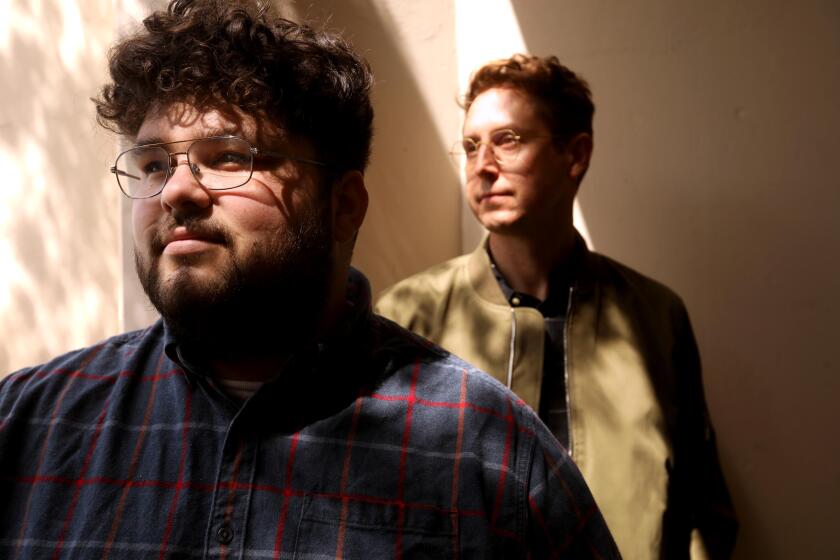Hammering Out a Better Future as a Carpenter
By the age of 16, Sam Guitron had already gotten his girlfriend pregnant, been kicked out of high school and become hooked on cocaine. To escape, he often climbed up a tree onto his mother’s roof to sit by himself.
Life would get worse before it got better. Worse was when Guitron started using heroin. Better was when, years later, he kicked drugs and found the carpenters.
They were teachers at Taller San Jose Tech, a Catholic agency in Santa Ana that teaches construction skills to young men with troubled pasts. They showed Guitron how, using the same arms he had scarred with needles, he could build a better life.
The carpenters teach their craft at a building a few blocks from Santa Ana’s courts, where young men shuffle in and out of county jail every day.
The agency’s name comes from Spanish: Taller means “workshop” and “San Jose” refers to St. Joseph. Joseph, the program’s founders believe, would have understood the young men they teach. The father of Jesus, he also is the patron saint of workers and was, like his son, a carpenter.
When the students enter the 15-week program, however, they are far from being saints or carpenters.
Most of them have criminal pasts, and almost half have not finished high school. Many, like Guitron, are fathers, but few have custody or visitation rights.
“They have no hope left,” said Shawna Smith, director of the program. “All they can do is go back to crime and gangs or go from one minimum-wage job to another.”
Smith and the Sisters of St. Joseph began the program in 2002 to give the men a shot at better jobs in home construction. Run by a staff of five, the program accepts 50 to 60 students a year.
So far, it has produced results; 86% of graduates find a construction job within the first month. The average starting wage is $9.91 an hour.
Part of the success, Smith said, is the result of a shortage of skilled workers in carpentry. Fundraising for the program, however, continues to be a problem, and the workshop is trying to make a deal with the city of Santa Ana and private companies for students to provide construction and repair services.
In the program, students are paid $7 an hour to attend classes from 8 a.m. to 4 p.m. The sessions are a mixture of mathematics, hands-on carpentry and life lessons.
“The math is the toughest thing,” said student Peter Estrada, 28. “Construction is all geometry: angles, pitches and board length. You don’t understand that, you don’t understand carpentry.”
Estrada, who began the program without a high school diploma, now can explain how designing the pitch of a roof requires a command of the Pythagorean theorem.
Before, he worked a string of minimum-wage jobs -- painter, welder and bouncer -- and was desperate for something better.
“I have two kids and a wife,” he said. “They need me.”
The curriculum is framed like a house. In 15 weeks, the students build a one-room home. Lessons start with the foundation. Then come floors, ceilings and drywalls; and finally roofing, wiring and plumbing.
One of the last lessons students learn is to build the stairs they will walk on at graduation. Stair-building is difficult because the pieces must fit perfectly. Making it to graduation is equally hard for them.
In the last 12 weeks, Estrada’s class has shrunk from 16 students to 10; on average, 30% of the students don’t graduate. Often, just as the men start thinking about a future, their pasts catch up with them.
“Some come in with warrants on their record,” said Sergio Ortega, one of three teachers. “Some are on probation. Some haven’t paid their child support.”
Work lasts Monday through Thursday. Fridays are reserved for trips to court, the Department of Motor Vehicles and a chance to recover strength for battles ahead.
Those who have quit gangs and drugs have it hardest, Ortega said. “We’re talking about whole families that live in the gang culture,” he said. “Sometimes, stepping away from that means leaving your family.”
Juan Karolys, 25, left his hometown of San Clemente when he gave up drugs two years ago. His addiction had led him in and out of jail and finally onto the streets, homeless.
“If you want to change, you have to change everything about you,” he said. “You cut all ties and walk away.”
The workshop is built on stories like Karolys’, Ortega said, because it requires a belief that people can change.
“Many times, even their families don’t believe in them anymore because they’ve heard promises before,” Ortega said. “When they come in, what they’re looking for is hope.”
When Guitron, 22, quit heroin, he also left his friends and hometown behind. In his backpack, besides a new red Bible, he keeps a photo from his past. It shows him with two teenage friends.
He pointed to the skinny kid on the left. “He’s in prison now for murder.”
He pointed to the one on the right, smiling happily, if dazedly. “He’s in an asylum.... Too much acid -- you know what I mean?”
Guitron lingered over the figure in the middle. “I never thought I’d make it past 16.”
Now, Guitron works on a construction crew that repairs homes for seniors. He also volunteers with a group that helps troubled teenagers.
“I figured, I could join a big company and make a lot of money, or I could come back and help others,” he said. “I guess I feel like I need to give back.”
More to Read
Start your day right
Sign up for Essential California for news, features and recommendations from the L.A. Times and beyond in your inbox six days a week.
You may occasionally receive promotional content from the Los Angeles Times.






